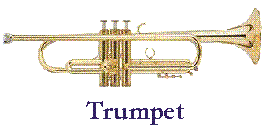Trumpet
Trumpet
Contents :
History
The ancient Egyptians had short trumpets for war. They were straight silver trumpets. The Greeks used a trumpet for the Olympics. It was called the salpinx. The Romans also used an instrument called a lituus. It was straight with the bell curved.
Trumpets called buzines and clarions were found in post-Roman Europe. The buzine was a long straight tube. The clarion was a smaller short tube with a bend.
The zigzag method of folding the tube first was developed in the 16th century. This is the principle which modern trumpets are made.
There were three species of trumpets by 1511. These were the clarion, military trumpet, and Thurner horn. The clarion was later used in orchestras.
Keys and tone holes were developed in the 17th century.
Valve mechanisms were developed and applied to the instrument. Valves were patented in 1818 by the German brass players Heinrich Stölzel and Friedrich Bluhmel in the early 19th century.
This made trumpets more versatile and enabled performers to play in tune with a larger range of notes. Slide trumpets were also invented but were not used.
The more developed trumpet replaced the clarion in the orchestra.
Top
Description
The modern trumpet has 4 feet 7 inches of tubing wrapped into the compact shape. It has a three valves and a cylindrical bore.
The trumpet is used in the orchestra because of its diversity. It has both a piercing, brassy sound and a soft, muted sound.

Top
Sound Production
Sound is produced by the player holding his lips tightly against a specially shaped mouthpiece. The lips vibrate when air is forced through them. This sets the air column in motion. The brass tube acts as a resonator.
The notes are produced by changing the length of the tube. This is accomplished through the use of valves. A valve at rest has air passing directly through it. A depressed valve causes the air to divert through extra tubing. This lengthens the air column.
